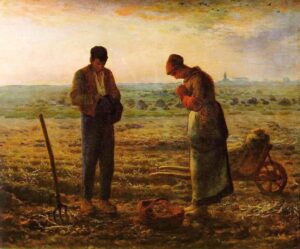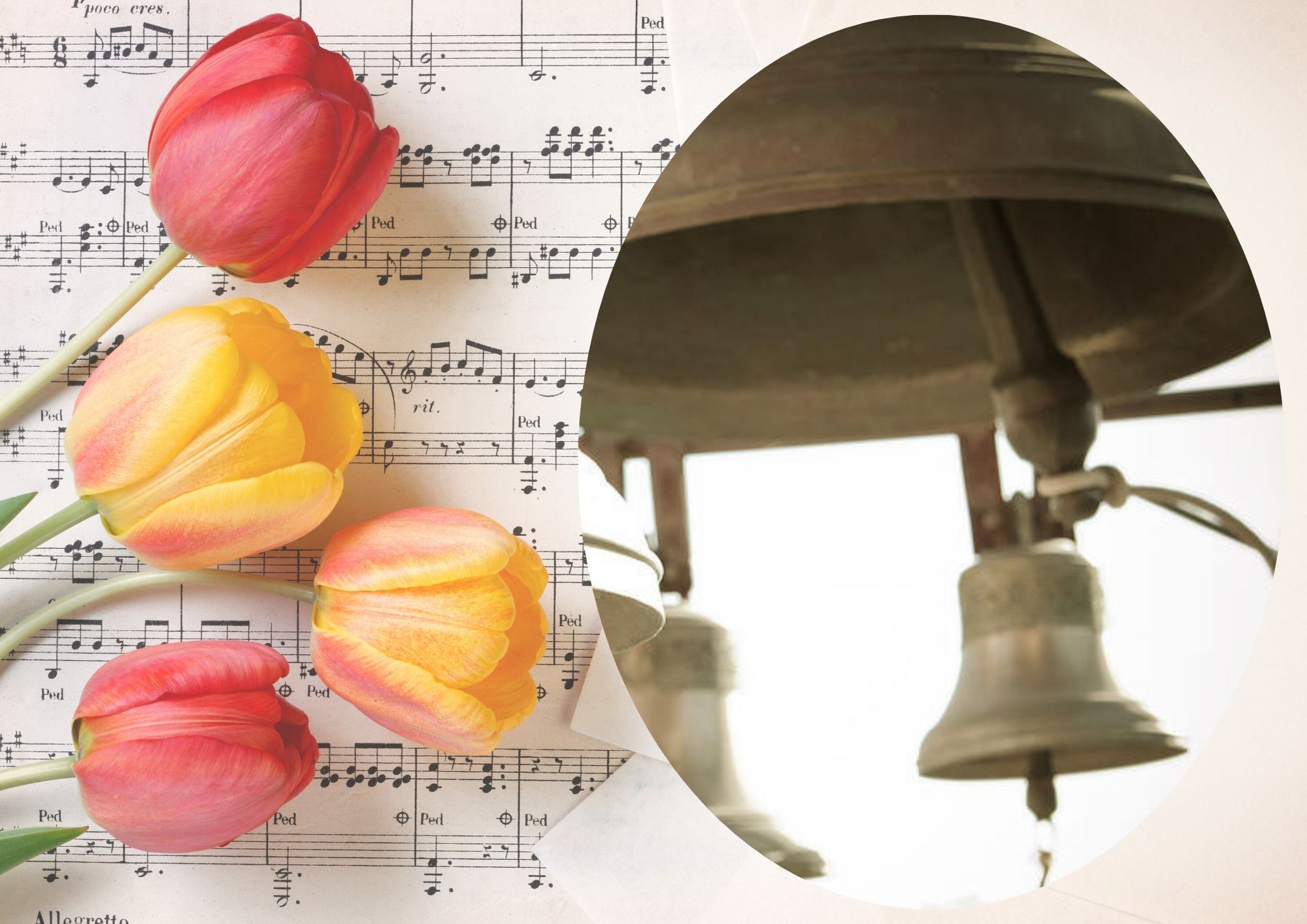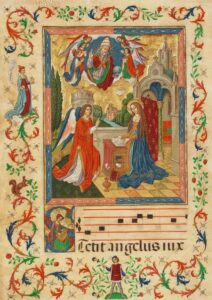The texte
℣. The angel of the Lord declared to Mary
℟. And she conceived of the Holy Ghost.
Hail Mary, full of grace, the Lord is with thee; blessed art thou among women and blessed is the fruit of thy womb, Jesus.
Holy Mary, Mother of God, pray for us sinners, now and at the hour of our death. Amen.
℣. Behold the handmaid of the Lord:
℟. Be it done unto me according to Thy word.
Hail Mary, full of grace, the Lord is with thee; blessed art thou among women and blessed is the fruit of thy womb, Jesus.
Holy Mary, Mother of God, pray for us sinners, now and at the hour of our death. Amen.
℣. And the Word was made Flesh:
℟. And he dwelt among us.
Hail Mary, full of grace, the Lord is with thee; blessed art thou among women and blessed is the fruit of thy womb, Jesus.
Holy Mary, Mother of God, pray for us sinners, now and at the hour of our death. Amen.
℣. Pray for us, O Holy Mother of God,
℟. That we may be made worthy of the promises of Christ.
Let us pray:
Pour forth, we beseech Thee, O Lord, Thy grace into our hearts; that we, to whom the incarnation of Christ, Thy Son, was made known by the message of an angel, may by His Passion and Cross be brought to the glory of His Resurrection, through the same Christ Our Lord.
Composition

Three times a day, the bell reminds us of the visit of the Archangel Gabriel to the Virgin Mary and the Incarnation of the Word, the greatest of the divine mysteries.
The three Angelus have different origins. The evening bell was the first to be used in the thirteenth century, then the morning bell in the fifteenth, and the noon bell in the fifteenth. Louis XI continued to spread this last practice.
The evening Angelus.
This pious practice is linked to the spread of the Ave Maria as a private prayer from the first centuries of the Church. In 1095, at the Council of Clermont, Urban II asked that the bells be rung in the morning and evening and that prayers be made in all cathedrals and churches for the success of the First Crusade. From the 12th century onwards, it became common practice to recite three Hail Marys. Saint Anthony of Padua (1195-1231) strongly recommended it. In 1269, Saint Bonaventure, during a chapter of the Friars Minor, proposed to recite these three Hail Marys in the evening after Compline, while meditating on the mystery of the Incarnation. It is said that Saint Bonaventure rang the bell to call the religious and the faithful of the neighbourhood to recite these three Ave. From that time, in the convent of the Friars Minor of Arrezo in Italy, this recitation was preceded by the Antiphon “Angelus locutus est Mariae…”. In Saintes, the custom of ringing the bells morning and evening, as requested by Urban II, had been preserved. In 1314, in Carpentras, Pope Clement V asked that the Ave Maria bell be rung after the singing of compline and in the Bull of Avignon of 13 October 1318, John XXII, a native of Cahors, recommended that “this pious custom established in Saintes be extended to the universal church” and granted an indulgence to the faithful who would recite the three Ave Maria on their knees. On 7 May 1327, the 78-year-old pope wrote to his vicar in Rome to introduce this custom, with an indulgence.
The Morning Angelus
This custom originated in England, first in the monasteries at the hour of the morning, and then spread everywhere. In 1399, the Archbishop of Cantorbery invited the Bishop of London to repeat the evening bell in the morning and to have the clergy and faithful pray an Our Father and five Ave. This practice was adopted in Pavia as early as 1330.
The Angelus at noon
In use in Omütz (in Czechoslovakia) in 1413 and in Mainz and Cologne in 1423, it was limited to Fridays and concerned only devotion to the Passion of Christ. In 1456, Pope Calixtus III, anxious to ward off the Turkish danger and the invasion of Eastern Europe by Islam, prescribed a prayer crusade, asking that the bells be rung three times a day and that three prayers be recited each time. The victory of Belgrade (1456) saved Christendom for a time, but the Turks remained threatening and dangerous. In 1472, King Louis XI prescribed the extension of the Angelus to the whole of his kingdom at noon and asked that this hour be prayed for peace. The Angelus at noon is therefore called the “Hail Mary of Peace”. It was indulged in 1475 by Pope Sixtus IV who, as a great Marian pope, especially favoured the liturgical cult of the Immaculate Conception. From then on, the triple Angelus with its triple ringing is attested to almost everywhere in the West… and in 1500 Pope Alexander VI confirmed the measures taken by Calixtus III in 1456 to ask for the victory over Islam through the Angelus.
To be prayed morning, noon and night, all year round, except during the Easter time, when it is substituted by the Regina Cæli
The text in Latin :
V. Angelus Domini nuntiavit Mariae,
R. Et concepit de Spiritu Sancto.
Ave Maria, gratia plena, Dominus tecum; benedicta tu in mulieribus, et benedictus fructus ventris tui, Iesus. Sancta Maria, Mater Dei, ora pro nobis peccatoribus, nunc et in hora mortis nostrae. Amen.
V. Ecce ancilla Domini,
R. Fiat mihi secundum verbum tuum.
Ave Maria, gratia plena, Dominus tecum; benedicta tu in mulieribus, et benedictus fructus ventris tui, Iesus. Sancta Maria, Mater Dei, ora pro nobis peccatoribus, nunc et in hora mortis nostrae. Amen.
V. Et Verbum caro factum est.
R. Et habitavit in nobis.
Ave Maria, gratia plena, Dominus tecum; benedicta tu in mulieribus, et benedictus fructus ventris tui, Iesus. Sancta Maria, Mater Dei, ora pro nobis peccatoribus, nunc et in hora mortis nostrae. Amen.
V. Ora pro nobis, sancta Dei Genitrix.
R. Ut digni efficiamur promissionibus Christi.
Oremus : Gratiam tuam, quaesumus, Domine, mentibus nostris infunde; ut, qui, angelo nuntiante, Christi Filii tui incarnationem cognovimus, per passionem ejus et crucem, ad resurrectionis gloriam perducamur. Per eumdem Christum Dominum nostrum. R. Amen.











